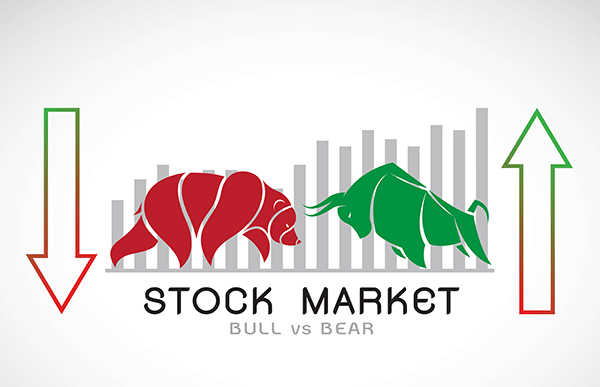Free Stock Trading Course
Lesson One
Introduction to Stock Trading
The first lesson in our free stock trading course provides an introduction to stock trading which includes an overview of the stock market, how the stock market works, what is stock trading, why do people trade stocks, the different types of stock traders, as well as highlighting some of the risks of stock trading.

What is the Stock Market?
The stock market is a platform where stocks (or shares) of publicly traded companies are bought and sold. It is a vital component of the global financial system, providing companies with access to capital, and investors with opportunities to earn returns on their investments.
When an individual or institution buys a stock, they become a shareholder of that company and are entitled to a portion of the company’s profits and assets. The stock market is a way for companies to raise capital and for investors to make money by buying shares of stock in companies they believe will be successful. The stock market is also known as the equity market, and the most well-known stock market is the New York Stock Exchange (NYSE) and Nasdaq.
The stock market is often divided into two main segments: the primary market and the secondary market. The primary market is where new securities are issued and sold to the public for the first time. The secondary market is where securities that have already been issued are bought and sold among investors. The stock market is a highly liquid market, meaning that assets can be easily bought and sold, and prices fluctuate based on supply and demand.
The stock market is also closely watched by investors, businesses, and governments as it is seen as a barometer of the overall health of the economy. A strong stock market is often seen as a sign of a healthy economy, while a weak stock market can be an indication of economic troubles.
How Does the Stock Market Work?
Investing in the stock market involves buying shares of ownership in publicly traded companies with the expectation that the value of those shares will increase over time. This can be done through a variety of methods, such as buying shares directly from a stock exchange, purchasing shares through a brokerage account, or investing in a mutual fund or exchange-traded fund (ETF) that holds a diversified portfolio of stocks.
When an individual or institution buys a stock, they become a shareholder of that company and are entitled to a portion of the company’s profits and assets. The value of a stock is determined by the market, which is influenced by a variety of factors such as the company’s financial performance, economic conditions, and investor sentiment.
To invest in the stock market, an individual typically opens a brokerage account with a financial institution. They can then buy and sell stocks through the brokerage account. Some individuals choose to work with a financial advisor or investment professional to help them make investment decisions.
When an individual buys a stock, they are essentially buying a small piece of the company and becoming a shareholder. They are also taking on the risk that the value of the stock may decrease. However, if the stock’s value increases, the shareholder can sell the stock for a profit. Stock market investing can be a way for individuals to grow their wealth over time, but it is important to keep in mind that it also comes with the risk of losing money.
Why do People Trade Stocks?
Stock trading has been a popular investment strategy for decades, and for good reason. Stocks offer the potential for substantial returns and can help individuals grow their wealth over time. The Introduction to Stock Trading lesson will highlight the main reasons why people trade stocks and what drives their decision-making.
Potential for high returns: One of the primary reasons people trade stocks is the potential for high returns. Stocks have historically provided higher returns than other asset classes such as bonds or real estate.
Diversification: Investing in stocks can help diversify an investor’s portfolio, spreading risk across multiple companies and sectors.
Passive income: Some investors trade stocks to generate passive income through dividend payments.
Speculation: Some traders buy and sell stocks based on short-term price movements, attempting to make a profit from market fluctuations.
Hedging: Institutional investors may use stock trading to hedge against other investments in their portfolio or to mitigate potential losses.
Ownership: By purchasing stocks, investors become owners of a portion of the company and can participate in its growth and success.
What are the Benefits of Stock Trading?
Stock Trading offers numerous opportunities for individuals to invest in companies and make a profit. While there are risks associated with stock trading, the potential benefits cannot be overlooked. The Introduction to Stock Trading lesson will highlight some of the benefits of stock trading.

One of the most significant benefits of stock trading is the potential for high returns on investment. Unlike traditional savings accounts or bonds, which offer relatively low returns, stocks can provide much higher returns, sometimes even double or triple your initial investment. For long-term investors, stock trading can be an excellent way to build wealth and secure a stable financial future.

Another benefit of stock trading is the ability to invest in companies you believe in or that align with your values. With stocks, you have the ability to choose which companies you want to invest in, which can be particularly appealing to individuals who are interested in a particular sector or socially responsible investing. This means that you can invest in companies that are making a positive impact on the world while also potentially earning a profit.
Stock trading also offers the flexibility to buy and sell shares quickly and easily, allowing investors to take advantage of market opportunities as they arise. This can be particularly appealing to those who enjoy actively managing their investments and staying on top of market trends.
Stock trading can provide a sense of ownership and engagement in the financial markets. By investing in companies and following their progress, individuals can become more knowledgeable about the economy and the business world as a whole.
In addition to these benefits, stock trading also provides a platform for diversification of investments. By investing in a variety of companies across different industries, investors can spread their risk and potentially earn higher returns.
While there are risks involved, the benefits of stock trading cannot be overlooked. The potential for high returns, the ability to invest in socially responsible companies, the flexibility to buy and sell shares quickly, and the opportunity for diversification make it an attractive option for many investors.
What are the Risks of Stock Trading?
Stock trading can be a great way to build wealth and achieve financial goals. However, it is important to understand that stock trading also involves risks. The Introduction to Stock Trading lesson highlights some of the risks of stock trading, and it is important for traders to be aware of these risks in order to make informed decisions.
One of the main risks of stock trading is market volatility. Stock prices can be affected by a wide range of factors, including economic conditions, political events, and company news. This means that stock prices can fluctuate rapidly and unpredictably. While this volatility can create opportunities for profit, it can also lead to significant losses.
Another risk of stock trading is the potential for fraud or scams. Unfortunately, there are individuals and companies that engage in fraudulent activities in the stock market. This can include insider trading, manipulation of stock prices, and Ponzi schemes. It is important for traders to do their due diligence and research any investment opportunities thoroughly before investing their money.
Leverage is another risk associated with stock trading. Many stock traders use leverage to increase their potential returns. However, leverage also increases the potential for large losses. Stock traders who use leverage need to be careful not to overextend themselves and to use risk management strategies like stop loss orders to protect their investments.
It is important to understand that investing in the stock market involves a degree of uncertainty. Even the most successful stock traders experience losses at times. It is important for investors to be prepared for these potential losses and to have a long-term investment strategy in place.
Despite these risks, there are also many benefits to stock trading. The stock market can provide opportunities for growth and financial independence. It can also be a way to invest in companies and industries that you believe in.
Stock trading involves risks, but it can also be a rewarding and profitable activity. The Introduction to Stock Trading lesson highlights some of the risks of stock trading, but it is important for traders to do their own research and make informed decisions. By understanding the risks and benefits of stock trading, traders can make informed investment decisions and achieve their financial goals.
What are the Different Types of Traders?
Stock trading has become a popular activity among investors and individuals looking to build wealth or generate additional income. However, not all traders are the same, and it is essential to understand the different types of stock traders.
The Introduction to Stock Trading lesson highlights different types of stock traders, including day traders, swing traders, position traders, and buy-and-hold investors. Day traders are individuals who buy and sell securities within the same trading day, attempting to profit from short-term market fluctuations. Swing traders hold stocks for a few days or weeks, looking to capture medium-term price movements. Position traders hold stocks for several months or years, focusing on long-term trends and fundamental factors. Finally, buy-and-hold investors purchase stocks with the intention of holding them for many years, often looking for dividend income or long-term capital appreciation.
Each type of trader has its own unique set of skills and strategies. Day traders need to be quick thinkers and have excellent technical analysis skills, while swing traders need to be able to identify key support and resistance levels. Position traders need to understand fundamental analysis, while buy-and-hold investors need to have a long-term investment mindset.
The different types of stock traders also have varying levels of risk and potential for reward. Day trading is often considered the riskiest, as traders are exposed to significant market volatility and must make quick decisions with little time for analysis. Swing trading and position trading can also be risky, as traders are exposed to market fluctuations and may face losses if their trades do not go as planned. Buy-and-hold investing is generally considered less risky, as investors can ride out short-term market volatility and focus on long-term trends.
Understanding the different types of stock traders is essential for anyone looking to trade stocks. The Introduction to Stock Trading lesson highlights different types of stock traders and their unique strategies and risk profiles. Whether you are a day trader, swing trader, position trader, or buy-and-hold investor, it is essential to have a clear understanding of your goals and risk tolerance before investing in the stock market.
This concludes the Introduction to Stock Trading lesson. Please use the menu below to navigate to the lesson of your choice.
